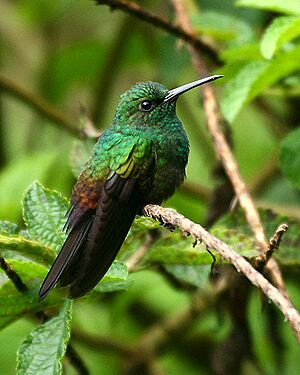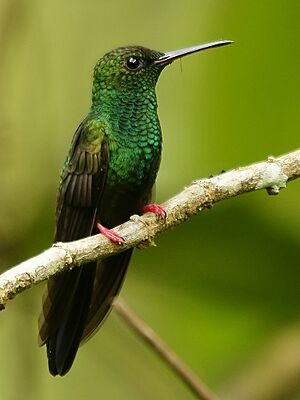Bronze-tailed plumeleteer facts for kids
Quick facts for kids Bronze-tailed plumeleteer |
|
|---|---|
 |
|
| Conservation status | |
| Scientific classification | |
| Genus: |
Chalybura
|
| Species: |
urochrysia
|
 |
|
| Range of Chalybura urochrysia | |
The bronze-tailed plumeleteer (Chalybura urochrysia) is a beautiful hummingbird. It belongs to a group of hummingbirds called "emeralds". You can find this bird in several countries. These include Colombia, Costa Rica, Ecuador, Nicaragua, and Panama.
Contents
About Bronze-tailed Plumeleteers
How Scientists Group Them
Scientists group living things into categories. This helps us understand how they are related. Most scientists agree that the bronze-tailed plumeleteer has three main types. These types are called subspecies. They are C. u. urochrysia, C. u. melanorrhoa, and C. u. isaurae.
Sometimes, one of these types, C. u. intermedia, is considered part of another hummingbird species. This other bird is the white-vented plumeleteer. The bronze-tailed and white-vented plumeleteers are the only two species in their specific bird group.
What They Look Like
The bronze-tailed plumeleteer is a small bird. It is about 10.5 to 12 centimeters (4.1 to 4.7 inches) long. Males weigh about 7.1 grams (0.25 ounces). Females are a bit lighter, at about 6.1 grams (0.22 ounces).
All bronze-tailed plumeleteers have a black upper beak. The tip of their lower beak is also black. The rest of the lower beak is usually dull pink or dark red.
Male and Female Birds
Male birds of the main type (C. u. urochrysia) have shiny green upper parts. Their undersides are also a sparkling green. They have long, fluffy white feathers under their tails. Their tails are a pretty bronze-green color.
Female birds of this type are metallic green on top. Their undersides are gray with green speckles on the sides. The feathers under their tails are grayish-white. The outer feathers of their tails have gray tips.
Young Birds
Young bronze-tailed plumeleteers look a lot like the adult birds. They have buff or cinnamon-colored edges on the feathers of their head, neck, and rump.
Different Subspecies' Colors
- Subspecies C. u. melanorrhoa males have darker green upper parts. Their tail-coverts (feathers covering the base of the tail) are purplish-bronze. Their undersides are darker, with a dusky bronze belly. The feathers under their tails are shorter and blackish. Their tails are purplish-black. Females of this type are darker gray underneath. They have more green speckles than the main type.
- Subspecies C. u. isaurae males have a blue throat and chest. Their belly is bluish-green. Their tail is a brighter bronze than the main type. Females of this type have pale gray undersides. They have very few, if any, green speckles.
Where They Live
The bronze-tailed plumeleteer lives in different parts of Central and South America.
- Subspecies C. u. melanorrhoa lives furthest north. You can find it from eastern Nicaragua into Costa Rica. It has also been seen a few times in eastern Honduras.
- Subspecies C. u. isaurae lives on the Caribbean side of Panama. It can also be found in some places on the Pacific side of Panama. Its range extends into the very northwestern part of Colombia.
- The main subspecies (C. u. urochrysia) lives from eastern Panama's Darién Province. Its range goes through north-central and western Colombia. It also reaches into northwestern Ecuador.
These birds like to live inside and at the edges of humid forests. They also live in older secondary forests (forests that have grown back after being cut down). You might also see them in semi-open areas like banana farms and gardens. They tend to avoid wide-open spaces. They live from sea level up to about 700 meters (2,300 feet) high in Costa Rica. In Colombia, they can be found up to 900 meters (3,000 feet) high.
How They Behave
How They Move Around
The C. u. melanorrhoa subspecies of the bronze-tailed plumeleteer sometimes moves locally. This means they travel short distances during different seasons. They probably do this to find flowering plants. We don't know much about the movements of the other two subspecies.
What They Eat
Bronze-tailed plumeleteers mostly eat nectar from flowers. They usually look for nectar in the lower and middle parts of the forest. They also visit plants that grow on other plants, like epiphytes, in the upper parts of the forest. They especially love Heliconia flowers. They will bravely defend patches of these flowers and other places with lots of nectar. They also eat nectar from plants like Renealmia, Costus, and Psychotria.
Besides nectar, they also catch small insects. They usually catch insects by flying out from a perch. They also pick insects off leaves.
How They Raise Their Young
Bronze-tailed plumeleteers breed in Costa Rica between December and June. Most breeding happens from February to April. In Colombia, they also seem to breed between February and April.
Their nest is best known from Costa Rica. They build a deep, cup-shaped nest. It is made of light plant fluff and fibers. They use spiderwebs to hold it together. The outside of the nest is covered with moss and some lichen. They usually place their nest in a shrub. It is typically about 0.5 to 1.5 meters (1.6 to 4.9 feet) above the ground. Often, the nest is near a stream or a path.
What They Sound Like
The song of the bronze-tailed plumeleteer is described as a soft, nasal, and scratchy trilled sound. It sounds like "ter-twee-ee-ee-ee-ee....ter-twee-ee-ee...". When they are chasing other birds, they make a long, chattering trill that goes down in pitch. They also make loud "chup" and "chip" sounds.
Their Conservation Status
The International Union for Conservation of Nature (IUCN) keeps track of how many animals there are. They have assessed the bronze-tailed plumeleteer as a "Least Concern" species. This means they are not currently in danger of disappearing.
We don't know the exact number of these birds. However, their population is thought to be decreasing. A lot of their natural home has been destroyed in Central America. But they are still common in many places.




